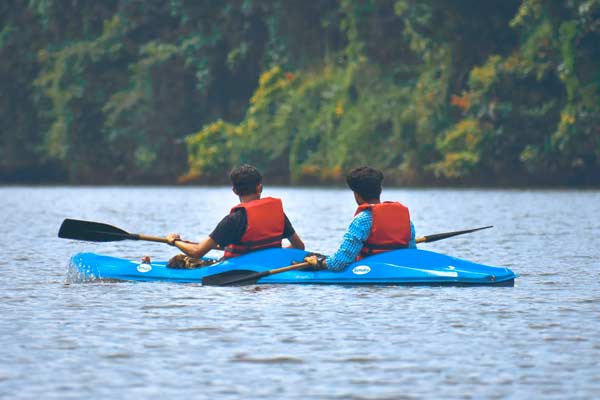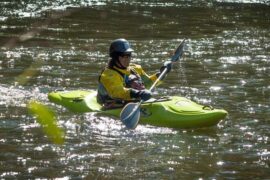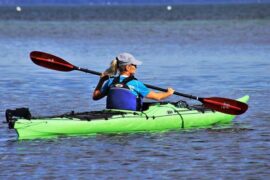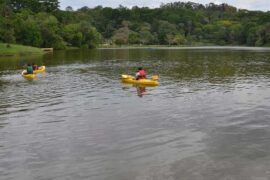Many people have wondered about this question, as a matter of safety and convenience, because a kayak is much more exposed to the elements than a larger boat would be.
When you’re out on a lake in a kayak, you don’t have much room in the vessel to maneuver, which means you’d like calm waters to navigate in.
However, kayaking in the rain is generally reasonably safe and can even provide some very memorable experiences for sports enthusiasts.
What about kayaking in the rain?
The quick and dirty answer to this is yes, you can go kayaking in the rain – as long as you’re prepared for it. You don’t want to be caught in a downpour with just a T-shirt on for protection, and you do have to pay attention to any building waves on the lake or pond.
A gentle rain is no problem, but you’ll need to be protected against hypothermia. A storm is much more problematic and likely to cause navigation difficulties, so it’s better to err on the side of caution and cut your kayaking trip short if the weather gets stormy.
Potential dangers of kayaking in the rain
Of course, you need to be aware of some potential dangers you might encounter when kayaking in the rain, so you don’t get caught off-guard. Here are some things to keep in mind:
- You may get tired more quickly than usual because you’ll probably be spending more energy on controlling your craft with stronger winds and waves.
- If you capsized, you would be exposed to the possibility of colliding with debris like branches or logs in the water.
- While in the water, you could ram into rocks or other obstructions in the lake.
- If a storm should follow the initial rain, there’s the possibility you could get hit by lightning or at least be exposed to powerful winds that could upset your kayak.
- If you aren’t dressed properly, you might quickly develop hypothermia due to the relatively cold rain soaking you. If your craft capsizes, this becomes much more likely.
Preparing for kayaking in the rain
Knowing the potential dangers that might be presented by kayaking in the rain is not the same as preparing for them.
You can do some things to be better prepared when you get surprised out on the lake by a sudden rainfall.
Sometimes you just don’t have any choice in the matter, and you’re forced to kayak in the rain because it wasn’t in the forecast and it came up unexpectedly.
If you happen to get caught in a surprise thunderstorm, your best bet is to get to shore as quickly as possible before things get ugly.
When the wind isn’t blowing too badly and the waves are manageable, you should be perfectly safe in enjoying your time on the lake. To be as prepared as possible for kayaking in the rain, here’s what you can do:
- Practice your safety and paddling skills so you’re ready for rougher weather.
- Before you go out, have a good idea of today’s forecast, and if there’s a chance for thunderstorms, you’d be well advised to re-schedule your kayak outing.
- Do not consume alcohol before kayaking – it can cause you to make poor decisions, and it interferes with your physical performance.
- Make sure you are well practiced in safe entry and exit from a kayak.
- Keep your swimming skills up to date if your boat capsizes, and you are obliged to swim back to shore.
- Wear a wetsuit, or at least dress appropriately for the possibility of being thoroughly soaked or completely immersed in the water.
- Exercise regularly so you are in a good state of fitness since you may be required to do a long swim back to shore.
- Have an emergency plan ready to cover the possibility of capsizing and becoming separated from your craft. This will help to prevent you from panicking should something undesirable, and unplanned occur while you’re on the water.
- Alert family and friends about your kayaking plans, so if any kind of accident happens, they’ll know something’s wrong when you’ve exceeded your planned time on the water.
- Ensure your kayak is seaworthy before going out so you don’t run into performance issues when the weather gets wetter.
- Wear a waterproof GPS watch to help you navigate in case you get lost or disoriented during the rainfall.
- Carry a repair and First Aid kit with you for emergencies.
- Make sure you’re wearing a flotation device to keep you buoyant in the water, should you capsize or accidentally fall in water.
What about kayaking after rainfall or storm?
It can be perfectly safe to go kayaking after rainfall or storm, provided that you take a few precautions. First, you must be aware of the water level after heavy rain.
If the waves have calmed down and the water level is safe, you should have no trouble enjoying a kayak trip on the lake.
You should be extra cautious if you know that the water you’ll be on is cold – this presents a much greater possibility of hypothermia, should you somehow become immersed.
As always, being on the water with a partner or friend is safer, just in case something goes wrong.
The same precautions you would take for paddling in the rain should be observed after a rainfall because another shower or two might spring up after the first one.
Kayaking can be extremely rewarding for a sports enthusiast, and it will be much more enjoyable if you’re better prepared for unpleasant possibilities.
By keeping the tips above in mind when you have a kayak outing, you should be able to weather the storm nicely and take away a remarkable memory of your experience.




